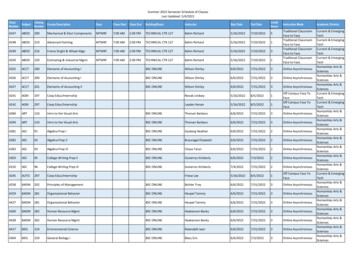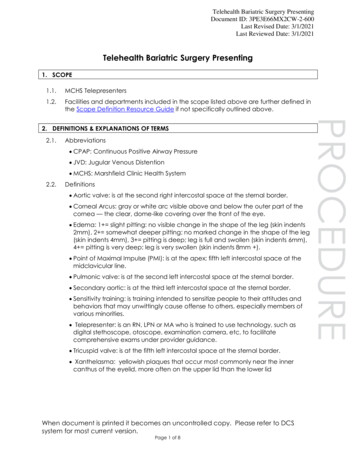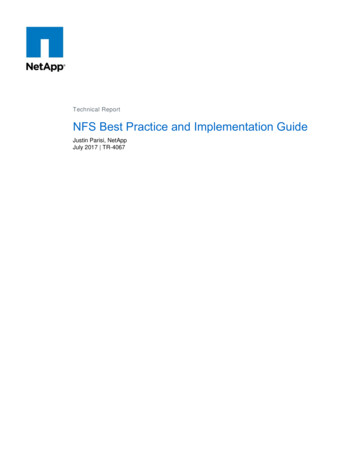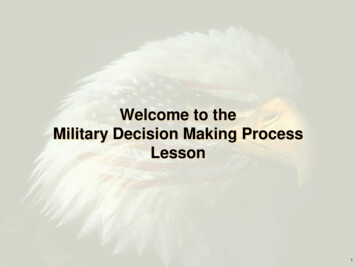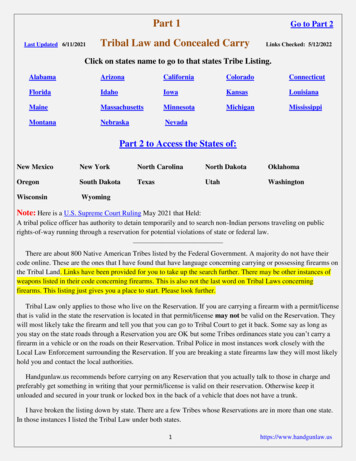
Transcription
Part 1Last Updated 6/11/2021Go to Part 2Tribal Law and Concealed CarryLinks Checked: 5/12/2022Click on states name to go to that states Tribe art 2 to Access the States of:New MexicoNew YorkNorth CarolinaNorth DakotaOklahomaOregonSouth DakotaTexasUtahWashingtonWisconsinWyomingNote: Here is a U.S. Supreme Court Ruling May 2021 that Held:A tribal police officer has authority to detain temporarily and to search non-Indian persons traveling on publicrights-of-way running through a reservation for potential violations of state or federal law.There are about 800 Native American Tribes listed by the Federal Government. A majority do not have theircode online. These are the ones that I have found that have language concerning carrying or possessing firearms onthe Tribal Land. Links have been provided for you to take up the search further. There may be other instances ofweapons listed in their code concerning firearms. This is also not the last word on Tribal Laws concerningfirearms. This listing just gives you a place to start. Please look further.Tribal Law only applies to those who live on the Reservation. If you are carrying a firearm with a permit/licensethat is valid in the state the reservation is located in that permit/license may not be valid on the Reservation. Theywill most likely take the firearm and tell you that you can go to Tribal Court to get it back. Some say as long asyou stay on the state roads through a Reservation you are OK but some Tribes ordinances state you can’t carry afirearm in a vehicle or on the roads on their Reservation. Tribal Police in most instances work closely with theLocal Law Enforcement surrounding the Reservation. If you are breaking a state firearms law they will most likelyhold you and contact the local authorities.Handgunlaw.us recommends before carrying on any Reservation that you actually talk to those in charge andpreferably get something in writing that your permit/license is valid on their reservation. Otherwise keep itunloaded and secured in your trunk or locked box in the back of a vehicle that does not have a trunk.I have broken the listing down by state. There are a few Tribes whose Reservations are in more than one state.In those instances I listed the Tribal Law under both states.1https://www.handgunlaw.us
If you know of any other Tribes that have their code online or links to Tribal Law/Tribal Governments that needlisted here please send the link to admins@handgunlaw.us. Please put Tribal Law in the subject line. Steve &GaryLinks to Tribal Codes mlLinks to Federal Recognized Tribal Governmentshttps://www.usa.gov/tribesLink for Jurisdictional Summary for crimes on Reservations - Dept of Justice 689.Link to Tribal Courts Clearing House - Tribal Laws/CodesLink to Tribal Gov. Sites by State - Tribal Government SitesLinks to Maps of Federal Lands and Native American Reservations - MapsLink to Court Ruling that Reservation Law only applies to those who live on the getcase.pl?court US&vol 435&invol 191Arizona Court Case with links to other court cases stating that just because the state has an easement for a stateroad through a Reservation doesn’t mean the Reservation still doesn’t own the property.USC › Title 18 › Part I › Chapter 53 › § 1162 State Jurisdiction Over Offenses Committed By or AgainstIndians in The Indian Country(a) Each of the States or Territories listed in the following table shall have jurisdiction over offenses committed by or againstIndians in the areas of Indian country listed opposite the name of the State or Territory to the same extent that such State orTerritory has jurisdiction over offenses committed elsewhere within the State or Territory, and the criminal laws of such Stateor Territory shall have the same force and effect within such Indian country as they have elsewhere within the State orTerritory:State orTerritory ofIndian country affectedAlaskaAll Indian country within the State, except that on Annette Islands, the Metlakatla Indian community mayexercise jurisdiction over offenses committed by Indians in the same manner in which such jurisdiction maybe exercised by Indian tribes in Indian country over which State jurisdiction has not been extended.CaliforniaAll Indian country within the State.MinnesotaAll Indian country within the State, except the Red Lake Reservation.NebraskaAll Indian country within the State.OregonAll Indian country within the State, except the Warm Springs Reservation.WisconsinAll Indian country within the State.(b) Nothing in this section shall authorize the alienation, encumbrance, or taxation of any real or personal property, includingwater rights, belonging to any Indian or any Indian tribe, band, or community that is held in trust by the United States or issubject to a restriction against alienation imposed by the United States; or shall authorize regulation of the use of suchproperty in a manner inconsistent with any Federal treaty, agreement, or statute or with any regulation made pursuant thereto;2https://www.handgunlaw.us
or shall deprive any Indian or any Indian tribe, band, or community of any right, privilege, or immunity afforded underFederal treaty, agreement, or statute with respect to hunting, trapping, or fishing or the control, licensing, or regulationthereof.(c) The provisions of sections 1152 and 1153 of this chapter shall not be applicable within the areas of Indian country listedin subsection (a) of this section as areas over which the several States have exclusive jurisdiction.(d) Notwithstanding subsection (c), at the request of an Indian tribe, and after consultation with and consent by the AttorneyGeneral—(1) sections 1152 and 1153 shall apply in the areas of the Indian country of the Indian tribe; and(2) jurisdiction over those areas shall be concurrent among the Federal Government, State governments, and, whereapplicable, tribal governments.Note:USC › Title 18 › Part I › Chapter 53 Is the US Code that concerns Tribal Laws etc.From the Bureau of Indian Affairs FAQsWhat is the jurisdiction of tribal courts?Generally, tribal courts have civil jurisdiction over Indians and non-Indians who either reside or do business onfederal Indian reservations. They also have criminal jurisdiction over violations of tribal laws committed by tribalmembers residing or doing business on the reservation.Under 25 C.F.R. Part 115, tribal courts are responsible for appointing guardians, determining competency,awarding child support from Individual Indian Money (IIM) accounts, determining paternity, sanctioningadoptions, marriages, and divorces, making presumptions of death, and adjudicating claims involving trust assets.There are approximately 225 tribes that contract or compact with the BIA to perform the Secretary’s adjudicatoryfunction and 23 Courts of Indian Offenses (also known as CFR courts) which exercise federal authority. TheIndian Tribal Justice Act of 1993 (P.L. 103-176, 107 Stat. 2005) supports tribal courts in becoming, along withfederal and state courts, well-established dispensers of justice in Indian Country.What is Public Law 280 and where does it apply?In 1953, Congress enacted Public Law 83-280 (67 Stat. 588) to grant certain states criminal jurisdiction overAmerican Indians on reservations and to allow civil litigation that had come under tribal or federal courtjurisdiction to be handled by state courts. However, the law did not grant states regulatory power over tribes orlands held in trust by the United States; federally guaranteed tribal hunting, trapping, and fishing rights; basic tribalgovernmental functions such as enrollment and domestic relations; nor the power to impose state taxes. Thesestates also may not regulate matters such as environmental control, land use, gambling, and licenses on federalIndian reservations.The states required by Public Law 280 to assume civil and criminal jurisdiction over federal Indian lands wereAlaska (except the Metlakatla Indian Community on the Annette Island Reserve, which maintains criminaljurisdiction), California, Minnesota (except the Red Lake Reservation), Nebraska, Oregon (except the WarmSprings Reservation), and Wisconsin. In addition, the federal government gave up all special criminal jurisdictionin these states over Indian offenders and victims. The states that elected to assume full or partial jurisdiction wereArizona (1967), Florida (1961), Idaho (1963, subject to tribal consent), Iowa (1967), Montana (1963), Nevada3https://www.handgunlaw.us
(1955), North Dakota (1963, subject to tribal consent), South Dakota (1957-1961), Utah (1971), and Washington(1957-1963).Subsequent acts of Congress, court decisions, and state actions to retrocede jurisdiction back to the FederalGovernment have muted some of the effects of the 1953 law, and strengthened the tribes’ jurisdiction over civiland criminal matters on their reservations.What are inherent powers of tribal self-government?Tribes possess all powers of self-government except those relinquished under treaty with the United States, thosethat Congress has expressly extinguished, and those that federal courts have ruled are subject to existing federallaw or are inconsistent with overriding national policies. Tribes, therefore, possess the right to form their owngovernments; to make and enforce laws, both civil and criminal; to tax; to establish and determine membership(i.e., tribal citizenship); to license and regulate activities within their jurisdiction; to zone; and to exclude personsfrom tribal lands.Limitations on inherent tribal powers of self-government are few, but do include the same limitations applicable tostates, e.g., neither tribes nor states have the power to make war, engage in foreign relations, or print and issuecurrency.Back To TopAlabamaPoarch Band of Creek Indians§8-6-17 Caring Concealed Weapons(a) A person commits the crime of carrying concealed weapons if said person, other than an authorized lawenforcement officer, shall carry concealed about his person any of the following weapons or firearms:(1) Air gun, blowgun, explosive device, bayonet, dagger, switchblade, bowie knife, slingshot, club, blackjack,chain, sword, spear, knuckles made of any metal or hard substance; knife having a blade of four (4) incheslong or longer, throwing stars, chain belts; or(2) Any gun or dangerous firearm whether the same is loaded or unloaded.(b) Carrying Concealed Weapons is a Class A Misdemeanor.Back To TopArizonaNote: FYI In “Jose ENRIQUEZ and Celestine Enriquez, Petitioners, v. The SUPERIOR COURT of the Stateof Arizona,” a Non-Indian and Indian had a car accident on a state route that went thru the Reservation. Thepetitioners wanted the case heard in the Arizona court system and the Reservation said no. In the arguments theReservation stated that they gave an easement for the highway but the land was still part of the reservation. TheCourt agreed with the Reservation.4https://www.handgunlaw.us
Colorado River Indian Tribes - CRIT Reservation(The Colorado River Indian Tribes include four distinct Tribes - the Mohave, Chemehuevi, Hopi and Navajo alongthe Colorado River on both the Arizona and California side.)Law and Order Code - Article 3 - Section 345. Carrying a Concealed Weapon.A person commits the offense of carrying a concealed weapon if, without legal justification, or lawful authorityas hereinafter provided, he knowingly carries concealed on or about his person a knife, firearm, or other dangerousweapon as hereinafter defined.a. It shall be an affirmative defense that the accused was:(1) Lawfully authorized to carry such knife, firearm or other dangerous weapon concealed on or abouthis person, which lawful authority shall be by permit issued by the Tribal Council or such otherauthority designated by it, or by written permit or other authority of the United States;(2) Was in a private automobile or other means of conveyance and was carrying the weapon therein forlawful protection of his or another permit or property while traveling.b. The following definitions apply to this Section:(1) ”Knife” means any dagger, dirk, knife, sword, spear, or stiletto with a blade over three and one-half(31/2) inches in length, or any other instrument capable of inflicting cutting, stabbing, or tearingwounds, but it does not include a hunting or fishing knife carried for sports or other lawful use.(2) “Firearm” means any gun, revolver, pistol, rifle, shotgun, or other weapon which discharges aprojectile by explosive force.(3) “Dangerous Weapon” in addition to a firearm or knife, includes any dart, blow-gun, air or pelletgun, non-safety razor, blackjack, billy club, sand club, sand bag, any hand-operated striking weaponconsisting at the striking end of an encased heavy substance or at the handle end a strap or springy shaftwhich increases the force of impact, any device designed for propelling by release of gas or springpressure, any device designed to discharge chemicals as an offensive or defensive weapon, a bomb orany other explosive or incendiary device or Molatov cocktail, brass knuckles or other device intendedto be worn on the hand or other part of the body for infliction of injury to another person.A person guilty of carrying a concealed weapon may be sentenced to imprisonment for a period notexceed one (1) year or a fine not to exceed Five Thousand Dollars ( 5,000.00), or both.[AsAmended January 11, 1992, Ord. No. 92-1, 1.]Fort McDowell Yavapai NationLaw and Order CodeSec. 6-123. - Carrying concealed weapon.A. A person is guilty of carrying concealed weapon who shall be armed with a dangerous weapon concealed uponhis person in a place other than their own home or residence, which weapon can be used to inflict harm uponanother person.B. A weapon is not a concealed weapon as used in this section if:5https://www.handgunlaw.us
1. It is carried in a belt holster, is wholly or partially visible, or is carried in a scabbard or case designed forcarrying weapons which scabbard or case is wholly or partially visible.2. It is located in a closed trunk, luggage or glove compartment of a motor vehicle.3. A person has a concealed weapon permit signed by the Arizona Department of Public Safety and has thepermit on his person.C. Law enforcement exception. This section shall not apply to duly commissioned law enforcement officials andother authorized employees of any tribal, state, or federal law enforcement agency while performing requiredfunctions within the scope of their official duties.D. Carrying concealed weapon is a Class II offense.(Law & Order Code 2006, § 6-123)Ft. Yuma Quechan Indians§ 13-3102. Misconduct Involving Weapons; Defenses; Classification; Definitions.A. A person commits misconduct involving weapons by knowingly:1. Carrying a deadly weapon without a permit except a pocket knife concealed on his person; or2. Carrying a deadly weapon without a permit concealed within immediate control of any person in or on ameans of transportation; orD. Subsection A, paragraphs 1, 2, 3, 7, 10, 11, 12 and 13, shall not apply to:1. A peace officer or any person summoned by any peace officer to assist and while actually assisting in theperformance of official duties; or2. A member of the military forces of the United States or of any state of the United States in the performance ofofficial duties; or3. A person specifically licensed, authorized or permitted pursuant to a statute of this state or of the UnitedStates.Gila River Indian Community5.1301. Misconduct Involving Weapons.A. A person commits the offense of misconduct involving weapons if he knowingly:1. Carries a deadly weapon except a pocket knife on his person or within his immediate control or in ameans of transportation, in the furtherance of an offense that is chargeable as a felony;10. Carries a deadly weapon on school premises, including any buildings and grounds, playgrounds,playing fields, parking area , or any school bus.Note: Handgunlaw.us recommends you read the whole law at the link above as it lists all the places firearms areprohibited and there is a Must Inform provision in their ordinances.Hualapai TribeThe Grand Canyon Skywalk is owned by the Hualapai Tribe. They do not have their ordinances online. TheirTribal website and the Skywalk website do not mention firearms or weapons. I have two reports now that firearms6https://www.handgunlaw.us
are not permitted. One reported the following: “The Skywalk building had no such signs. But, within theSkywalk building, there is a separate corridor to the walkway. At the entrance to that corridor, there is a metaldetector and a staff member with a hand wand.”HavasupaiInformation (From their website on visiting them in the Grand Canyon)The Havasupai Tribe does not permit it's people to use alcoholic beverages on the reservation and drugs are asillegal in Havasu Canyon as they are anywhere else. Tribal law does not permit the bearing of firearms by anyoneon the reservation, nor are machetes, either necessary, or useful in the campgrounds.From the Above Link:Hopi TribeChapter 11. Offenses Involving Weapons And Explosives3.11.1 Misconduct Involving Firearms. A person who knowingly discharges a firearm within three hundred(300) feet of any inhabited building or on any road or highway within the Territory, is guilty of a petty offense.A. This offense shall not apply to persons who discharge their firearms for ceremonial or law enforcementpurposes, to those who discharge their firearms in protection of their farming or ranching activities, to those whodischarge their firearms within a designated area such as an archery or rifle range, or to those who discharge theirfirearms in accordance with other laws of the Tribe.B. In addition to such other penalties prescribed by this Code, the firearm may be immediately seized as a civilforfeiture.Navajo NationTitle 17, Chpt. 3, Subchpt. 3, Weapons and Explosives§ 320. Unlawful Carrying of a Deadly WeaponA. Offense. A person commits unlawful carrying of a deadly weapon if he or she carries a loaded firearm or anyother type of deadly weapon.B. Exceptions. Subsection (A) of this Section shall not apply to any of the following:1. To peace officers in the lawful discharge of their duties;2. To persons in a private motor vehicle or other means of conveyance, for lawful protection of the person's oranother's person or property, while traveling and such weapon is located in a closed trunk, luggage, or glovecompartment of a motor vehicle;7https://www.handgunlaw.us
3. To a person in his or her residence, or on real property belonging to such person as owner, lessee, tenant, orlicensee;4. To a person or persons carrying or discharging a firearm as an integral part of any traditional Navajo religiouspractice, ceremony, or service;5. To persons engaged in the hunting of game or predatory animals.Pascua Yaqui TribeSubchapter E Guns; ExplosivesSection 490 Carrying a Concealed or Deadly Weapon (4 PYTC § 1-490)(A) Any person who shall go about in public places armed with a dangerous or deadly weapon, concealed orunconcealed, shall be deemed guilty of an offense.(B) Any person who shall go about in any Tribal Enterprise or Other Enterprise, or the premises of such TribalEnterprise or Other Enterprise, armed with a dangerous or deadly weapon, concealed or unconcealed, shall bedeemed guilty of an offense.(C) "Deadly weapons" within the meaning of the foregoing shall be construed to mean any and all kinds andclasses of offensive weapons, such as guns, pistols, revolvers, knives with blades over four inches in length, andany and all classes and kinds of weapons and instruments by whatever name called, designed to or intended andused for the purpose of inflicting a dangerous wound.(D) “Other Enterprise” means any retail, commercial, or entertainment facilities that may be operated on theTribe’s Reservation by any entity or individual other than the Tribe.(E) “Tribal Enterprise” means Casino del Sol, Casino of the Sun, the Anselmo Valencia Tori Amphitheater, theChevron gas station, the Tribe’s resort, conference center, parking structure, and warehouse facility, and any otherretail, commercial, or entertainment facilities or venues that may be hereafter operated by the Tribe on the Tribe’sReservation.(F) Commissioned peace officers shall be exempt from this section 490.Tohono O'odham NationTitle 7 Chapter 1Section 14.1 Misuse of a Weapon and/or a Dangerous InstrumentA. A person commits the offense of misuse of a weapon and/or a dangerous instrument if he or she intentionallyor knowingly:1. carries a prohibited weapon or dangerous instrument concealed on or about his or her person; or2. carries a prohibited weapon concealed in or on a means of transportation, or within immediate reach ofany person; or3. carries or possesses a prohibited weapon or dangerous instrument with the intent to use such weapon ordangerous instrument in the commission of a crime; or4. carries or possesses a prohibited weapon or dangerous instrument and is a prohibited person as defined inthis section; or8https://www.handgunlaw.us
5. manufactures, transports, sells or transfers a prohibited weapon; or6. discharges a firearm within one-fourth (1/4) mile of an occupied residence.7. defaces or alters the serial number of a firearm or possesses a firearm whose serial number has beendefaced or altered with the knowledge that the firearm serial number was defaced or altered.8. enters any public gathering or attends any public event and carries a prohibited weapon or dangerousinstrument on his or her person.D. For purposes of this section a weapon is not concealed if:1. it is carried in a belt holster, wholly or partially visible, or is carried in a case designed for carryingweapons; or2. the weapon is located in a closed trunk, luggage or locked glove compartment of a motor vehicle;3. the person carrying the weapon is authorized to carry the weapon.E. A person found guilty of misuse of a weapon and/or a dangerous instrument shall be sentenced to thefollowing:1. Imprisonment in jail for a period not to exceed three hundred sixty (360) days; or2. A fine not to exceed one thousand dollars ( 1000); or3. Both of the above.Salt River Pima-Maricopa Indian CommunitySec. 6-151. Misconduct involving weapons; permits.A permit issued by the Salt River Police Department is required to possess a firearm or ammunition in theCommunity. The Salt River Police Department may issue a permit authorizing possession by persons within theSalt River Pima-Maricopa Indian Community of non-prohibited weapons, and weapons for which a certificate ofinoperability has been issued.(1) Conditions on permit. Application for a permit shall be conditioned on the applicant's acceptance of thejurisdiction of the Salt River Pima-Maricopa Indian Community in any civil action for damages resulting from thepossession or operation of the weapon by the applicant.(2) Limitations on permit. Without exception, prohibited possessors are not eligible to apply for or be issuedpermits to possess firearms or ammunition within the Salt River Pima-Maricopa Indian Community.(3) Regulation of permits. The Salt River Police Department shall regulate the application and approval process forfirearms and weapons permits using policies and procedures approved by the Salt River Pima-Maricopa IndianCommunity Tribal Council. Such regulation shall incorporate the prohibitions included in this section.Sec. 6-152. Misconduct involving weapons; offenses.(a) Possession without a permit. It shall be unlawful for any person to operate, possess, receive, transport, or shipany firearm or ammunition within the Salt River Pima-Maricopa Indian Community unless such person hasobtained a permit from the Salt River Police Department. Possession without a permit is a class B offense.White Mountain ApacheCriminal CodeSection 2.18 Carrying a Concealed WeaponA. A person is guilty of an offense who has concealed on or about his person, or within his immediate control, aDangerous Weapon.9https://www.handgunlaw.us
B. Subsection A shall not apply to any person authorized by any tribal government, or state government, or by thegovernment of the United States or any subdivision of any of the aforementioned governments to carry suchweapon.C. A person found guilty under this Section may be sentenced to imprisonment for a period not to exceed OneHundred Eighty (180) days or to any a fine not to exceed Five Hundred Dollars ( 500.00), or both.D. Any weapons concealed in violation of this Section shall be subject to seizure and forfeiture as provided in theWhite Mountain Apache Rules of Criminal Procedure.Back To TopCaliforniaCA DOJ & Gambling Control CommissionCalifornia Tribal-State Gaming CompactSec. 10.6. Possession of firearms shall be prohibited at all times in the Gaming Facility except for state, local, ortribal security or law enforcement personnel authorized by tribal law and by federal or state law to possess firearms at the Facility.Blue Lake Rancheria TribeLaw and Order Ordinance 16-01Section 5.02 Carrying a Prohibited Weapon(A) A person commits carrying a Prohibited Weapon if he or she carries on or about his or her person a dangerousweapon. For this subsection only a dangerous weapon shall not include a firearm that is registered with the State orthe Tribe and authorized by the Tribe’s administrator for concealed carry (CCW) purposes. This subsection shallnot apply to Tribal Police Officers or any other state, federal or tribal law enforcement officer.(B) Any Tribal Police Officer or other tribally designated security or law enforcement officer may, upon probablycause, confiscates a dangerous weapon from any person who violates this subsection.Cahto Tribe of the Laytonville RancheriaSection 3.02 Infractions Against the Peace(B) Carrying a Prohibited Weapon(1) A person commits the Infraction of Carrying a Prohibited Weapon if he or she carries on or about his or herperson a dangerous weapon. For this subsection only a dangerous weapon shall not include a firearm that isregistered with the State or the Tribe. This subsection shall not apply to Tribal Police Officers or any other state,federal or tribal law enforcement officer.(2) Any Tribal Police Officer or other tribally designated security or law enforcement officer may, upon probablecause, confiscate a dangerous weapon from any person who violates this subsection.10https://www.handgunlaw.us
Colorado River Indian Tribes - CRIT Reservation(The Colorado River Indian Tribes include four distinct Tribes - the Mohave, Chemehuevi, Hopi and Navajo alongthe Colorado River on both the Arizona and California side.)Law and Order Code - Article 3 - Section 345. Carrying a Concealed Weapon.A person commits the offense of carrying a concealed weapon if, without legal justification, or lawful authorityas hereinafter provided, he knowingly carries concealed on or about his person a knife, firearm, or other dangerousweapon as hereinafter defined.c. It shall be an affirmative defense that the accused was:(3) Lawfully authorized to carry such knife, firearm or other dangerous weapon concealed on or abouthis person, which lawful authority shall be by permit issued by the Tribal Council or such otherauthority designated by it, or by written permit or other authority of the United States;(4) Was in a private automobile or other means of conveyance and was carrying the weapon therein forlawful protection his or another permit or property while traveling.d. The following definitions apply to this Section:(1) ”Knife” means any dagger, dirk, knife, sword, spear, or stiletto with a blade over three and one-half(31/2) inches in length, or any other instrument capable of inflicting cutting, stabbing, or tearingwounds, but it does not include a hunting or fishing knife carried for sports or other lawful use.(2) “Firearm” means any gun, revolver, pistol, rifle, shotgun, or other weapon which discharges aprojectile by explosive force.(3) “Dangerous Weapon” in addition to a firearm or knife, includes any dart, blow-gun, air or pelletgun, non-safety razor, blackjack, billy club, sand club, sand bag, any hand-operated striking weaponconsisting at the striking end of an encased heavy substance or at the handle end a strap or springy shaftwhich increases the force of impact, any device designed for propelling by release of gas or springpressure, any device designed to discharge chemicals as an offensive or defensive weapon, a bomb orany other explosive or incendiary device or Molatov cocktail, brass knuckles or other device intendedto be worn on the hand or other part of the body for infliction of injury to another person.A person guilty of carrying a concealed weapon may be sentenced to imprisonment for a period notexceed one (1) year or a fine not to exceed Five Thousand Dollars ( 5,000.00), or both.[AsAmended January 11, 1992, Ord. No. 92-1, 1.]Coyote Valley Band of Pomo IndiansSection 5.02 Carrying a Prohibited Weapon(Code no longer available online)(A) A person commits Carry a Prohibited Weapon if he or she carries on or about his or her person a dangerousweapon. For this subsection only a dangerous weapon shall not include a firearm that is registered with the State orthe Tribe. This subsection shall not apply to Tribal Police Officers or any other state, federal or tribal lawenforcement officer.(B) Any Tribal Police Officer or other tribally designated security or law enforcement officer many, upon probablecause, confiscate a dangerous weapon from any person who violates this subsection.11https://www.handgunlaw.us
Hoopa Valley TribeSection 5.02 Carrying a Prohibited Weapon(A) A person commits Carrying a Prohibited Weapon if he or she carries on or about his or her person a dangerousweapon. F
Minnesota All Indian country within the State, except the Red Lake Reservation. Nebraska All Indian country within the State. . Nothing in this section shall authorize the alienation, encumbrance, or taxation of any real or personal property, including water rights, belonging to any Indian or any Indian tribe, band, or community that is held .






